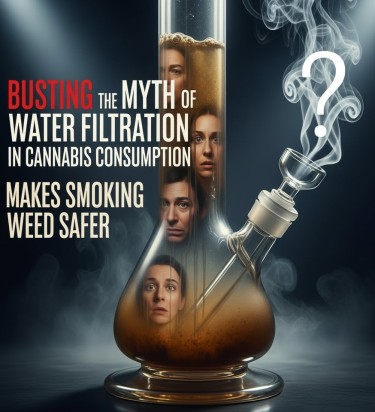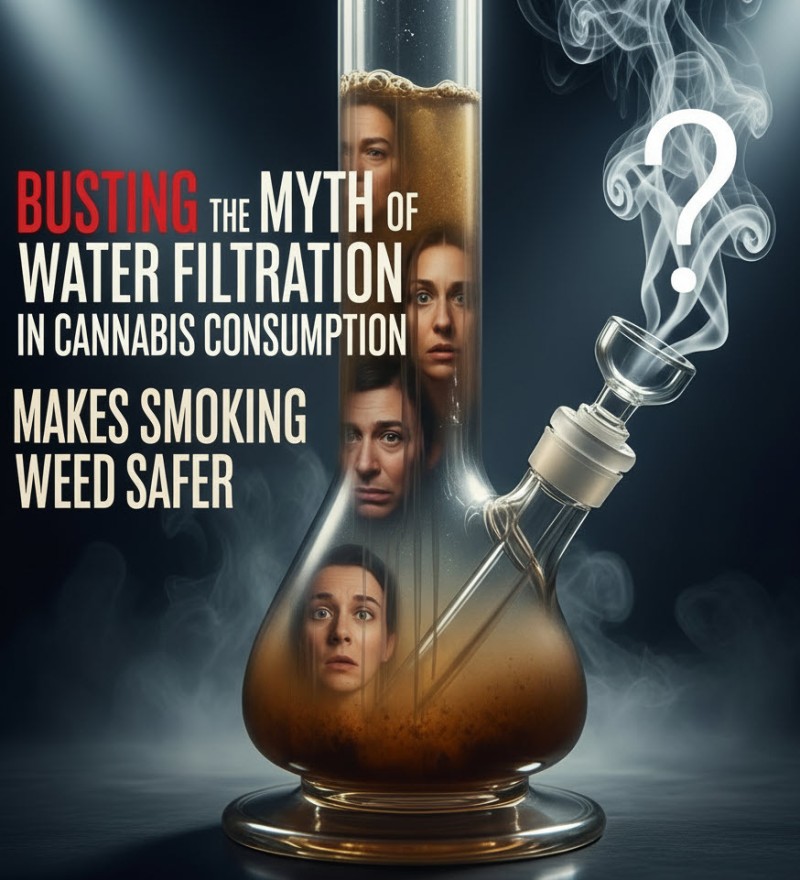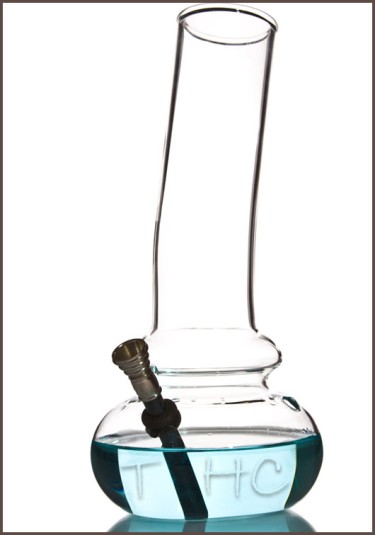
The Big Bong Theory: Busting the Myth of Water Filtration in Cannabis Consumption
For as long as I can remember, there's been an almost religious belief in the cannabis community that water filtration makes smoking safer. Walk into any head shop and you'll hear the gospel according to glass: bongs filter out the bad stuff, joints are harsh, and water is your lungs' best friend. It's conventional wisdom so deeply entrenched that questioning it feels almost heretical.
But here I am, about to commit cannabis blasphemy by asking a simple question: what if we've been wrong this whole time?
A new study from researchers at the University of Wisconsin-Madison and Thailand has dropped a bombshell that's shaking the foundation of stoner science. Using sophisticated gas chromatography-mass spectrometry – the kind of equipment that can identify compounds by their molecular weight – they analyzed smoke from three popular strains consumed through both joints and bongs. The results? "Bong water does not seem to significantly filter out any compound from the smoke."
Now, before you start throwing your favorite piece at me, let's think about this rationally. We've spent decades assuming that pulling smoke through water must be doing something beneficial, right? Water filters, after all, are everywhere – from our kitchen taps to swimming pools. The logic seems sound: harmful particles get trapped in water, cleaner smoke reaches your lungs, everybody wins.
But what if the reality is more complicated than our stoner logic suggests? What if the cooling effect of water has been masking the fact that we're not actually filtering out much of anything? And more importantly, what does this mean for the millions of cannabis users who've invested in elaborate glass collections believing they were making healthier choices?
This isn't just about settling bar arguments or validating gear purchases. As cannabis legalization expands and we move toward treating this plant with the scientific rigor it deserves, we need to separate fact from folklore. We need to understand what we're actually inhaling and whether our consumption methods are based on solid science or just really persistent myths.
So let's dive into the big bong theory and see if our beloved water pipes are the harm reduction heroes we thought they were, or if we've all been participating in one of the longest-running cases of cannabis confirmation bias in history.
The Science Behind the Splash: What the Study Actually Found
The University of Wisconsin-Madison study represents one of the most comprehensive attempts to scientifically examine what actually happens when you filter cannabis smoke through water. Using gas chromatography-mass spectrometry (GC-MS) – the gold standard for chemical analysis – researchers put three popular strains (Bubble Gum, Silver Haze, and Hang Over OG) through rigorous testing.
Here's what they discovered: the chemical composition of smoke from joints and bongs was nearly identical. No compounds in the 5 to 350 grams per mole range were completely filtered out by the bong water. In other words, whatever was in the joint smoke was also present in the bong smoke at essentially the same levels.
This finding challenges decades of assumptions about water filtration. The researchers found no compounds that appeared only in joint smoke and not in bong smoke, suggesting that within their testing parameters, water wasn't capturing any significant components of cannabis smoke.
But here's where it gets interesting – and where we need to be careful about drawing absolute conclusions. The GC-MS method used in this study has limitations. It couldn't detect larger particles, aerosols, or metal ions that water might theoretically filter out. This is crucial because much of the harm from smoke comes from particulates and tar – the bigger, nastier stuff that this particular testing method couldn't measure.
Think of it like this: if you're trying to catch fish with a net, but your net only catches fish between 5 and 35 centimeters, you might conclude that there are no fish smaller than 5cm or larger than 35cm in the water. But that doesn't mean those fish don't exist – you just can't detect them with your current equipment.
The study did reveal some fascinating insights about cannabis smoke composition. β-cis-Caryophyllene appeared in the highest concentrations across all samples, regardless of consumption method. This compound has potential anti-inflammatory, antibiotic, antioxidant, and even anticarcinogenic properties – meaning some components of cannabis smoke might actually be beneficial rather than harmful.
The researchers were careful to acknowledge their study's limitations. They noted that "sample size and smoke loss during collection" affected their results, and that their equipment was "limited in its ability to detect larger particles, aerosols, and metal ions." This scientific humility is important – they're not claiming bongs are useless, just that within their specific testing parameters, they didn't see significant filtration.
Perhaps most importantly, the study highlights a critical gap in cannabis research. Unlike tobacco, which has decades of standardized testing methods, cannabis science is still playing catch-up. The researchers noted that "establishing standardized analytical approaches could support more accurate assessments of cannabis quality, health risks, and therapeutic potential."
So what does this mean for the average cannabis consumer? The study suggests that if you're choosing a bong over a joint purely for health reasons, you might not be getting the protection you think you are – at least not for the smaller molecular compounds that this study could measure. But the jury's still out on whether water filtration helps with larger particles and other potentially harmful components of smoke.
Beyond Bongs: The Wider World of Water Filtration
While the University of Wisconsin study focused specifically on traditional bongs, the world of cannabis water filtration extends far beyond your basic beaker setup. From elaborate multi-chamber percolators to ash catchers and diffusion systems, the glass industry has built an entire ecosystem around the premise that more water contact equals cleaner smoke.
Let's examine what these various filtration systems claim to do and whether the science supports their effectiveness. Percolator bongs, for instance, force smoke through multiple water chambers or intricate glass structures designed to break smoke into smaller bubbles, theoretically increasing water contact time and surface area. The logic is appealing – more interaction with water should mean more filtration, right?
Then there are ice catches, which cool smoke before it reaches your lungs, and ash catchers that pre-filter smoke before it enters the main chamber. Some high-end pieces incorporate multiple percolation stages, turning smoke passage into an elaborate obstacle course through various water chambers.
The problem is that most of these innovations are based on intuition rather than empirical evidence. The glass industry has essentially been conducting a decades-long experiment in smoke filtration without actually measuring the results. It's like designing increasingly complex air filters without ever testing whether they actually remove more particles from the air.
But here's where things get interesting from a physics perspective. Water should theoretically filter out some components of smoke – that's basic science. When smoke bubbles through water, larger particles can get trapped through several mechanisms: impaction (particles stick to water droplets), interception (particles get caught as they pass close to water surfaces), and diffusion (smaller particles move erratically and contact water molecules).
The question isn't whether water can filter particles – it's which particles matter for health and whether traditional bong designs are effective at removing them. The Wisconsin study showed that many smaller molecules pass through water largely unchanged, but what about the stuff that might actually harm your lungs?
Tar and larger particulates are the primary health concerns with combusted cannabis smoke. These are exactly the components that water filtration should theoretically address most effectively. Unfortunately, the current study couldn't measure these larger particles, leaving us with incomplete information about what might be the most important aspect of filtration.
There's also the cooling effect to consider. Even if water doesn't filter out harmful compounds, it does cool smoke significantly, which can reduce throat and lung irritation. This cooling effect might explain why bong hits feel "smoother" even if they're not actually cleaner from a chemical standpoint.
The cannabis community has also experimented with other filtration media. Some users add activated charcoal to their water, others use specialized filtration attachments, and some have even tried unusual liquids instead of water. While these modifications might provide additional filtration benefits, they remain largely untested in controlled scientific settings.
What we need is research that specifically examines larger particulates, tar content, and other components that current GC-MS analysis can't detect. Until then, we're left with educated guesses about whether all these elaborate glass contraptions are actually protecting our health or just making our smoking experience feel more sophisticated.
Clearing the Water on Cannabis Consumption
So where does this leave us in our understanding of water filtration and cannabis consumption? The truth is, we're somewhere between scientific revelation and "more research needed" – that frustrating gray area that defines so much of cannabis science.
The Wisconsin study has definitely punctured some holes in our collective confidence about bong superiority, but it hasn't definitively proven that water filtration is useless. What it has shown is that our assumptions about cannabis consumption methods need to be examined with the same scientific rigor we'd apply to any other health-related practice.
Here's my take: if you prefer bongs because they feel smoother, cooler, or more enjoyable, knock yourself out. The cooling effect alone provides legitimate benefits in terms of comfort and reduced throat irritation. But if you're choosing a bong solely because you believe it's significantly safer than other consumption methods, you might want to reconsider that assumption.
The bigger lesson here is about the importance of evidence-based thinking in cannabis culture. For too long, we've relied on conventional wisdom and anecdotal evidence to guide our consumption choices. As cannabis becomes increasingly mainstream and scientifically studied, we need to be willing to question our sacred cows – even if one of those sacred cows happens to be a beautiful hand-blown glass masterpiece.
The future of cannabis harm reduction lies in actual scientific research, not just intuitive assumptions about how things should work. Whether that research ultimately validates or debunks the big bong theory, we'll all be better off knowing the truth. Until then, consume responsibly, stay curious, and maybe don't throw away that vaporizer just yet.






